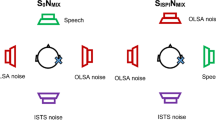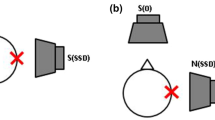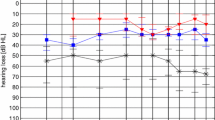Abstract
Bone-anchored hearing implants (BAHI) are routinely used to alleviate the effects of the acoustic head shadow in single-sided sensorineural deafness (SSD). In this study, the influence of the directional microphone setting and the maximum power output of the BAHI sound processor on speech understanding in noise in a laboratory setting were investigated. Eight adult BAHI users with SSD participated in this pilot study. Speech understanding in noise was measured using a new Slovak speech-in-noise test in two different spatial settings, either with noise coming from the front and noise from the side of the BAHI (S90N0) or vice versa (S0N90). In both spatial settings, speech understanding was measured without a BAHI, with a Baha BP100 in omnidirectional mode, with a BP100 in directional mode, with a BP110 power in omnidirectional and with a BP110 power in directional mode. In spatial setting S90N0, speech understanding in noise with either sound processor and in either directional mode was improved by 2.2–2.8 dB (p = 0.004–0.016). In spatial setting S0N90, speech understanding in noise was reduced by either BAHI, but was significantly better by 1.0–1.8 dB, if the directional microphone system was activated (p = 0.046), when compared to the omnidirectional setting. With the limited number of subjects in this study, no statistically significant differences were found between the two sound processors.




Similar content being viewed by others
References
Dun CA, Faber HT, de Wolf MJ, Cremers CW, Hol MK (2011) An overview of different systems: the bone-anchored hearing aid. Adv Otorhinolaryngol 71:22–31
Dumper J, Hodgetts B, Liu R, Brandner N (2009) Indications for bone-anchored hearing aids: a functional outcomes study. J Otolaryngol Head Neck Surg 38(1):96–105
Janssen RM, Hong P, Chadha NK (2012) Bilateral bone-anchored hearing aids for bilateral permanent conductive hearing loss: a systematic review. Otolaryngol Head Neck Surg 147(3):412–422
Rasmussen J, Olsen SØ, Nielsen LH (2012) Evaluation of long-term patient satisfaction and experience with the Baha® bone conduction implant. Int J Audiol 51(3):194–199
Wazen JJ, Spitzer JB, Ghossaini SN, Fayad JN, Niparko JK, Cox K et al (2003) Transcranial contralateral cochlear stimulation in unilateral deafness. Otolaryngol Head Neck Surg 129(3):248–254
Stewart CM, Clark JH, Niparko JK (2011) Bone-anchored devices in single-sided deafness. Adv Otorhinolaryngol 71:92–102
Faber HT, de Wolf MJ, Cremers CW, Snik AF, Hol MK (2013) Benefit of Baha in the elderly with single-sided deafness. Eur Arch Otorhinolaryngol 270(4):1285–1291
Lieu JE (2004) Speech-language and educational consequences of unilateral hearing loss in children. Arch Otolaryngol Head Neck Surg 130(5):524–530
Lieu JE, Tye-Murray N, Fu Q (2012) Longitudinal study of children with unilateral hearing loss. Laryngoscope 122(9):2088–2095
Noh H, Park YG (2012) How close should a student with unilateral hearing loss stay to a teacher in a noisy classroom? Int J Audiol 51:426–432
Pfiffner F, Caversaccio MD, Kompis M (2011) Comparisons of sound processors based on osseointegrated implants in patients with conductive or mixed hearing loss. Otol Neurotol 32(5):728–735
Bosman AJ, Snik FM, Mylanus EA, Cremers WR (2009) Fitting range of the BAHA Intenso. Int J Audiol 48(6):346–352
Stenfelt S (2005) Bilateral fitting of BAHAs and BAHA fitted in unilateral deaf persons: acoustical aspects. Int J Audiol 44:178–189
Wesarg T (2009) Speech discrimination in noise and lateralization in unilateral deaf patients using the Baha-Intenso. Poster presentation at the 2nd International symposium on Bone Conduction Hearing-Cranofacial Osseointegration (Gothenburg, Sweden)
Oeding K, Valente M, Kerckhoff J (2010) Effectiveness of the directional microphone in the Baha Divino. J Am Acad Audiol 21(8):546–557
Desmet JB, Wouters K, De Bodt M, Van de Heyning P (2012) Comparison of 2 implantable bone conduction devices in patients with single-sided deafness using a daily alternating method. Otol Neurotol 33(6):1018–1026
Flynn MC, Hillbratt M (2012) Improving the accuracy of Baha® fittings through measures of direct bone conduction. Clin Exp Otorhinolaryngol 5(Suppl 1):S43–S47
Pfiffner F, Kompis M, Flynn M, Åsnes K, Arnold A, Stieger C (2011) Benefits of low frequency attenuation of Baha® in single sided sensorineural deafness. Ear Hear 32(1):40–45
Håkansson B, Carlsson P (1989) Skull simulator for direct bone conduction hearing devices. Scand Audiol 18:91–98
Kompis M, Pfiffner F, Krebs M, Caversaccio M (2011) Factors influencing the decision for Baha in unilateral deafness: the Bern benefit in single-sided deafness questionnaire. Adv Otorhinolaryngol 71:103–111
Hirsch I (1950) The relation between localization and intelligibility. J Acoust Soc Am 22(2):196–200
Linstrom CJ, Silverman CA, Yu GP (2009) Efficacy of the bone-anchored hearing aid for single sided deafness. Laryngoscope 119:713–720
Bosman AJ, Hol MK, Snik AF et al (2003) Bone-anchored hearing aids in unilateral inner ear deafness. Acta Otolaryngol 123:258–260
Stenfelt S (2011) Acoustic and Physiologic Aspects of Bone Conduction Hearing. Adv Otorhinolaryngol 71:10–21
Acknowledgments
We thank Cochlear Inc. for their valuable support.
Conflict of interest
Co-author F.P. works part time for the University Hospital of Bern (Inselspital) and part time for Cochlear Inc. The flights of 2 members of the Swiss group to Kosice for the measurements were paid for by Cochlear Inc.
Author information
Authors and Affiliations
Corresponding author
Rights and permissions
About this article
Cite this article
Krempaska, S., Koval, J., Schmid, C. et al. Influence of directionality and maximal power output on speech understanding with bone anchored hearing implants in single sided deafness. Eur Arch Otorhinolaryngol 271, 1395–1400 (2014). https://doi.org/10.1007/s00405-013-2565-2
Received:
Accepted:
Published:
Issue Date:
DOI: https://doi.org/10.1007/s00405-013-2565-2




